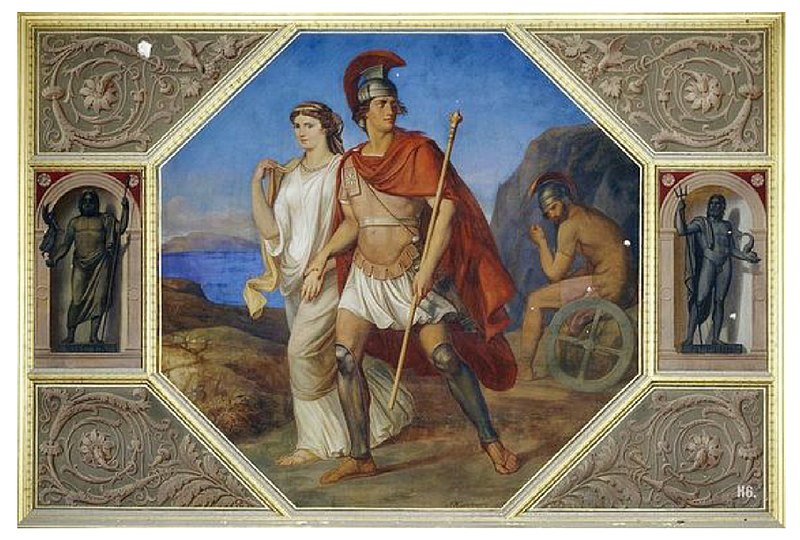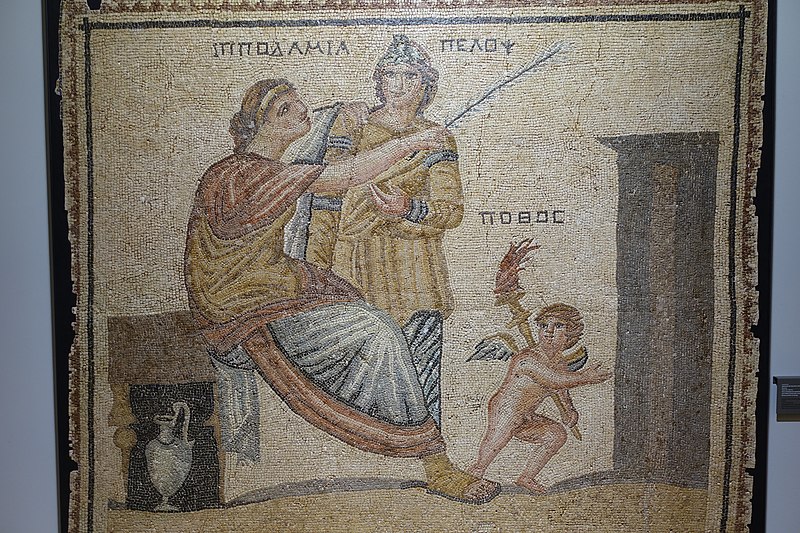Among the many heroes of Greek mythology, few figures are as intriguing as Pelops. This hero, often overshadowed by the more renowned demigods and deities, has a tale that intertwines fate, ambition, and the complexities of human relationships.
Pelops Key Facts
| Parents | Tantalus and Dione |
| Partners | Hippodamia |
| Siblings | Niobe and Broteas |
| Offspring | Atreus, Thyestes, Chrysippus, and others |
| Other names | – |
| Roman name | Pelops |
| Best Known Myth | The chariot race for Hippodamia’s hand |
Name and Etymology
The etymology of “Pelops” is somewhat debated, but one popular theory suggests it derives from the Greek words “pelos” (dark) and “ops” (face or eye), possibly alluding to his distinctive appearance. His Roman counterpart retains the same name, a testament to the character’s significance across cultures. Throughout various texts, he’s occasionally referred to by epithets, but none as prominent as his original name.

Pelops’ Family and Relationships
The intricate web of relationships in Greek mythology often paints a vivid picture of love, betrayal, and destiny. Pelops, the central figure in several myths, was no exception. Born into royalty, he was the king of the city of Pisa in the Peloponnesus region, a title that brought with it both privilege and peril.
Pelops was the offspring of Tantalus and, depending on the version of the myth, his mother could have been the Titaness Dione, Euryanassa, Eurythemista, or Clytia. This lineage placed him in the heart of many tales, as he was part of the dynasty of the Atreides, a line known for its tragic destinies.
His siblings, too, were figures of note. Niobe, his sister, became the unfortunate mother who lost all her children and was turned into a stone, forever weeping. Broteas, another sibling, had his own tales, though not as prominent as Niobe’s.
As for Pelops’ own children, his union with Hippodamia bore several, each with their own destinies intertwined with the larger stories of Greek myths. Their sons included Atreus and Thyestes, who would later be central figures in tales of betrayal and vengeance. Other sons like Pittheus, Alcathous, and Chrysippus had their own roles to play in the myths. Pelops and Hippodamia also had daughters, some of whom married into the House of Perseus, further connecting Pelops to other significant figures in Greek mythology.
Pelops’ life was a testament to the complexities of family ties in these ancient tales. As a king, a father, a son, and a brother, his relationships were a mix of love, ambition, treachery, and destiny, reflecting the multifaceted nature of human connections in the world of gods and mortals.
Myths about Pelops
The tales of Pelops stand out with a unique blend of passion, treachery, and divine intervention. As we delve into his stories, we uncover a hero whose life was marked by both blessings and curses, showcasing the delicate balance between mortal ambitions and the whims of the gods.
Pelops and the Curse of Tantalus
Pelops’ early life was marred by the actions of his father, Tantalus. In a twisted attempt to test the gods’ omniscience, Tantalus decided to serve his own son, Pelops, as a meal to the gods on Mount Olympus. The gods, however, were not easily fooled. They immediately recognized the abomination before them and refrained from eating, except for Demeter, who consumed a part of Pelops’ shoulder. Realizing the gravity of Tantalus’ actions, the gods decided to resurrect Pelops. Hephaestus, the god of the forge, crafted an ivory shoulder to replace the missing part, marking Pelops with a unique blend of mortality and divinity.
Pelops and Hippodamia: A Race for Love
Pelops’ tale is also deeply intertwined with that of Hippodamia, the beautiful daughter of King Oenomaus of Pisa. Oenomaus, having heard a prophecy that he would be killed by his son-in-law, devised a deadly chariot race. Any suitor wishing to marry Hippodamia had to win this race against Oenomaus. The stakes were high: victory meant marrying Hippodamia, while defeat led to death.
Pelops, smitten by Hippodamia’s beauty, was determined to win. He sought the favor of Poseidon, who gifted him a golden chariot with winged horses. But Pelops took no chances. He also conspired with Myrtilus, Oenomaus’ charioteer, promising him half of Oenomaus’ kingdom and a night with Hippodamia in exchange for sabotage. Myrtilus replaced the lynchpins of Oenomaus’ chariot with ones made of wax. During the race, as Oenomaus was about to overtake Pelops, the wax melted, causing his chariot to fall apart and leading to his death.
However, Pelops’ treachery did not end there. Fearing Myrtilus might betray him, Pelops threw him off a cliff. As he fell, Myrtilus cursed Pelops and his lineage, leading to a series of tragic events for his descendants, including Atreus and Thyestes.
Legacy and the Olympic Games
Pelops’ significance in Greek mythology extends far beyond his personal tales. It has left a lasting impact on one of the most celebrated events in ancient Greece: the Olympic Games. Following his triumphant victory in the race against King Oenomaus, Pelops felt the weight of his death on his conscience. To express his gratitude to the gods and seek purification from the act of treachery that led to Oenomaus’ demise, Pelops organized grand chariot races. These races were not just a tribute to the gods but also served as funeral games in honor of King Oenomaus.
It was this very funeral race, held in the sacred grounds of Olympia, that sowed the seeds for what would later blossom into the ancient Olympic Games. This event, initially a religious occasion, transformed over time into a grand spectacle that drew participants and spectators from all over Greece. Pelops’ legacy, thus, was not just confined to his own tales but also resonated in the rhythmic gallop of horses and the roar of cheering crowds that marked the Olympic Games, a testament to the enduring nature of myths and their influence on culture and tradition.
Depiction And Characteristics
Pelops, in the eyes of those who penned his tales, was a figure of determination and ambition. Often depicted as a handsome young man, his most distinguishing feature was his ivory shoulder, a reminder of his resurrection by the gods. Symbols associated with him primarily revolve around chariots and horses, echoing his most famous myth.
His personality, as gleaned from myths, was multifaceted. While his love for Hippodamia showcased his romantic side, his methods to secure her hand revealed a more cunning and ambitious nature. The Ancient Greeks saw in Pelops a reflection of their own societal values and the dichotomy of human nature—where love and ambition often walk hand in hand.

Representations Of Pelops In Art
The world of ancient art is replete with depictions of Pelops, especially in the context of his iconic chariot race. Vases from the Classical period often showcase the pivotal moments of this race, with Pelops and Oenomaus in fierce competition. Statues and reliefs, too, have immortalized this hero, capturing his youthful vigor and determination.
One particularly renowned artwork is a metope from the Temple of Zeus at Olympia, showcasing the moment of Pelops’ victory. Such depictions both highlight the importance of his myth and the values and ideals of the society that revered him.
Mentions in Ancient Texts
The tales of Pelops, a central figure in Greek mythology, have been immortalized in various ancient Greek literary works. These texts not only chronicle his adventures but also provide a window into the cultural fabric of ancient Greece.
Pindar’s Odes
Pindar, the renowned lyric poet from Thebes, often touched upon the legends of Pelops in his odes. Circa 522-443 BC, he wrote about the infamous banquet organized by Tantalus, Pelops’ father. Pindar describes how Tantalus, in an attempt to test the gods, served Pelops as a meal to the Olympians. This act of treachery led to Tantalus’ banishment and Pelops’ eventual resurrection. Moreover it also explains how hegot an ivory shoulder crafted by Hephaestus replacing the part consumed by Demeter.
Homer’s Epics
Homer, the legendary ancient Greek epic poet, often interwove the tales of heroes like Pelops into his grand narratives. In Homer’s epic, “The Iliad,” from the 8th century BC, Pelops is referenced in the context of the Trojan War. His lineage plays a significant role, with characters like Agamemnon and Menelaus being his descendants. A notable excerpt mentions, “From Pelops the noble prince was descended…”
Euripides’ Dramas
The tragedian Euripides, one of the great playwrights of ancient Athens, also made references to Pelops in his dramas. His works, which date back to the 5th century BC, often delve into the complexities of human relationships and fate. Pelops’ lineage and the curse that befell his descendants being recurring themes.
Frequently Asked Questions
Pelops was the son of Tantalus and Dione.
The chariot race against King Oenomaus for Hippodamia’s hand stands out as his most iconic tale.
Yes, notable figures from the Trojan War, like Agamemnon and Menelaus, were his descendants.
He had an ivory shoulder, a result of his resurrection by the gods.
He triumphed in a chariot race against her father, using both divine aid and cunning.
Yes, several ancient artworks, especially vases and statues, depict scenes from his life, particularly the chariot race.
Featured Image Credit: Anonymous, Public domain, via Wikimedia Commons
